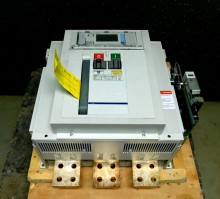 Loading... Please wait...
Loading... Please wait...- Home
- Circuit Breakers & Disconnectors
- Allen-Bradley 140G 2500A R-Frame Molded Case Circuit Breaker 125kA 480V 3ph
Allen-Bradley 140G 2500A R-Frame Molded Case Circuit Breaker 125kA 480V 3ph
Product Description
A circuit breaker is a reusable semi-automatic switching device. Circuit breakers are designed to protect downstream devices and wiring from harmful conditions in the power supply that run through the breaker, while also allowing the complex power demands of the system to pass through. Breaker design specifics are defined by multiple standards: Bulletin 140G circuit breakers are broadly designed for global industrial application for low-voltage, three-phase power systems and are subject to the details of both UL and IEC standards. The technical definition of a circuit breaker varies between standards organizations. Following are some commonly used definitions:
• The National Electrical Manufacturers Association (NEMA) defines circuit breakers as “devices designed to open and close a circuit by non-automatic means, and to open the circuit automatically on a predetermined overcurrent without injury to itself when properly applied within its rating.”
• The International Electrotechnical Commission (IEC) Standard IEC 60947-2 defines a circuit breaker as “a mechanical switching device, capable of making, carrying and breaking currents under normal circuit conditions and also making, carrying for a specified time, and breaking currents under specified abnormal circuit conditions such as those of short-circuit.”
Customers Who Viewed This Product Also Viewed
-
$2,115.00

-
$2,785.00

-
$9,805.00

-
$6,775.00

















